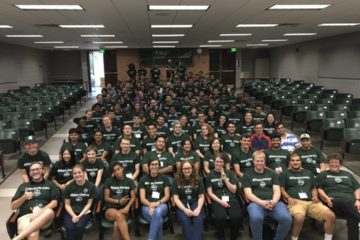We found 257 results that contain "venturit"
Posted on: #iteachmsu

Artificial Intelligence Modelling Language. AIML is an XML based markup language
AIML stands for Artificial Intelligence Markup Language. AIML was developed by the Alicebot free software community and Dr. Richard S. Wallace during 1995-2000. AIML is used to create or customize Alicebot which is a chat-box application based on A.L.I.C.E. (Artificial Linguistic Internet Computer Entity) free software.
AIML Tags
Following are the important tags which are commonly used in AIML documents.
S.No.
AIML Tag / Description
1
<aiml>
Defines the beginning and end of a AIML document.
2
<category>
Defines the unit of knowledge in Alicebot's knowledge base.
3
<pattern>
Defines the pattern to match what a user may input to an Alicebot.
4
<template>
Defines the response of an Alicebot to user's input.
We'll discuss each of these tags in AIML Basic tags chapter.
Following are some of the other widely used aiml tags. We'll be discussing each tag in details in coming chapters.
S.No.
AIML Tag / Description
1
<star>
Used to match wild card * character(s) in the <pattern> Tag.
2
<srai>
Multipurpose tag, used to call/match the other categories.
3
<random>
Used <random> to get random responses.
4
<li>
Used to represent multiple responses.
5
<set>
Used to set value in an AIML variable.
6
<get>
Used to get value stored in an AIML variable.
7
<that>
Used in AIML to respond based on the context.
8
<topic>
Used in AIML to store a context so that later conversation can be done based on that context.
9
<think>
Used in AIML to store a variable without notifying the user.
10
<condition>
Similar to switch statements in programming language. It helps ALICE to respond to matching input.
AIML Vocabulary
AIML vocabulary uses words, space and two special characters * and _ as wild cards. AIML interpreter gives preference to pattern having _ than pattern having *. AIML tags are XML compliant and patterns are case-insensitive.
Example
<aiml version = "1.0.1" encoding = "UTF-8"?>
<category>
<pattern> HELLO ALICE </pattern>
<template>
Hello User!
</template>
</category>
</aiml>
Following are the important points to be considered −
<aiml> tag signifies start of the AIML document.
<category> tag defines the knowledge unit.
<pattern> tag defines the pattern user is going to type.
<template> tag defines the response to the user if user types Hello Alice.
Result
User: Hello Alice
Bot: Hello User
AIML Tags
Following are the important tags which are commonly used in AIML documents.
S.No.
AIML Tag / Description
1
<aiml>
Defines the beginning and end of a AIML document.
2
<category>
Defines the unit of knowledge in Alicebot's knowledge base.
3
<pattern>
Defines the pattern to match what a user may input to an Alicebot.
4
<template>
Defines the response of an Alicebot to user's input.
We'll discuss each of these tags in AIML Basic tags chapter.
Following are some of the other widely used aiml tags. We'll be discussing each tag in details in coming chapters.
S.No.
AIML Tag / Description
1
<star>
Used to match wild card * character(s) in the <pattern> Tag.
2
<srai>
Multipurpose tag, used to call/match the other categories.
3
<random>
Used <random> to get random responses.
4
<li>
Used to represent multiple responses.
5
<set>
Used to set value in an AIML variable.
6
<get>
Used to get value stored in an AIML variable.
7
<that>
Used in AIML to respond based on the context.
8
<topic>
Used in AIML to store a context so that later conversation can be done based on that context.
9
<think>
Used in AIML to store a variable without notifying the user.
10
<condition>
Similar to switch statements in programming language. It helps ALICE to respond to matching input.
AIML Vocabulary
AIML vocabulary uses words, space and two special characters * and _ as wild cards. AIML interpreter gives preference to pattern having _ than pattern having *. AIML tags are XML compliant and patterns are case-insensitive.
Example
<aiml version = "1.0.1" encoding = "UTF-8"?>
<category>
<pattern> HELLO ALICE </pattern>
<template>
Hello User!
</template>
</category>
</aiml>
Following are the important points to be considered −
<aiml> tag signifies start of the AIML document.
<category> tag defines the knowledge unit.
<pattern> tag defines the pattern user is going to type.
<template> tag defines the response to the user if user types Hello Alice.
Result
User: Hello Alice
Bot: Hello User
Authored by:
AIML stands for Artificial Intelligence Modelling Languag...

Posted on: #iteachmsu

NAVIGATING CONTEXT
What is Attention Deficit Hyperactivity Disorder?
What is Attention Deficit Hyperactivity Disorder?
Classroom Interventions for Attention Deficit/ Hyperactivity Disorder Considerations Packet
Primer text from The College of William & MaryADHD is one of the most commonly diagnosed conditions of children (Centers for DiseaseControl and Prevention, 2015).
In a 2016 Centers for Disease Control and Prevention study, scientists found that 6.1 million children aged 2-17 years living in the U.S. had been diagnosed with attention-deficit/hyperactivity disorder (ADHD), which is similar to previous en
Ages 6-11: Approximately 2.4 million children
Ages 12-17: Approximately 3.3 million children
The diagnostic term attention deficit/hyperactivity disorder (ADHD) refers to individuals who display patterns of inattention, impulsivity, and overactive behavior that interfere with daily functioning (American Psychiatric Association [APA], 2013).
The Diagnostic and Statistical Manual (DSM) V (APA, 2013) criteria for diagnosing ADHD listthree types of ADHD and the accompanying characteristics.
The student may:o Appear to be in constant motion,o frequently fidget or move in his or her seat,o become restless during quiet activities,o leave his or her seat when expected to remain seated,o interrupt others and classroom activities,o talk excessively, and/oro fail to follow classroom procedures (e.g., blurt out answers without raising hand).
Combined type. The student may exhibit symptoms that include behaviors from both categories above.
In order for a student to be diagnosed with ADHD, symptoms must appear before age 12 and be exhibited across at least two settings. They must also have adverse effects on academic performance, occupational success, or social-emotional development (APA, 2013).
To add to the complexity of the diagnosis, children with ADHD are likely to have co-existing emotional, behavioral, developmental, learning, or physical conditions (Wolraich & DuPaul, 2010).
Classroom Interventions for Attention Deficit/ Hyperactivity Disorder Considerations Packet
Primer text from The College of William & MaryADHD is one of the most commonly diagnosed conditions of children (Centers for DiseaseControl and Prevention, 2015).
In a 2016 Centers for Disease Control and Prevention study, scientists found that 6.1 million children aged 2-17 years living in the U.S. had been diagnosed with attention-deficit/hyperactivity disorder (ADHD), which is similar to previous en
Ages 6-11: Approximately 2.4 million children
Ages 12-17: Approximately 3.3 million children
The diagnostic term attention deficit/hyperactivity disorder (ADHD) refers to individuals who display patterns of inattention, impulsivity, and overactive behavior that interfere with daily functioning (American Psychiatric Association [APA], 2013).
The Diagnostic and Statistical Manual (DSM) V (APA, 2013) criteria for diagnosing ADHD listthree types of ADHD and the accompanying characteristics.
The student may:o Appear to be in constant motion,o frequently fidget or move in his or her seat,o become restless during quiet activities,o leave his or her seat when expected to remain seated,o interrupt others and classroom activities,o talk excessively, and/oro fail to follow classroom procedures (e.g., blurt out answers without raising hand).
Combined type. The student may exhibit symptoms that include behaviors from both categories above.
In order for a student to be diagnosed with ADHD, symptoms must appear before age 12 and be exhibited across at least two settings. They must also have adverse effects on academic performance, occupational success, or social-emotional development (APA, 2013).
To add to the complexity of the diagnosis, children with ADHD are likely to have co-existing emotional, behavioral, developmental, learning, or physical conditions (Wolraich & DuPaul, 2010).
Posted by:
Archana Chaurasia

Posted on: #iteachmsu


What is Attention Deficit Hyperactivity Disorder?
What is Attention Deficit Hyperactivity Disorder?
Classroom Interv...
Classroom Interv...
Posted by:
NAVIGATING CONTEXT
Friday, Feb 17, 2023
Posted on: #iteachmsu

DISCIPLINARY CONTENT
Opportunities to Respond
In creating peer-mediated activities, the teacher may need to choose students whoseskill levels complement each other. Students with and without attention difficulties andimpulsivity should be considered for peer partnerships.
Authored by:
Piffner

Posted on: #iteachmsu


Opportunities to Respond
In creating peer-mediated activities, the teacher may need to choos...
Authored by:
DISCIPLINARY CONTENT
Tuesday, Feb 8, 2022
Posted on: #iteachmsu

NAVIGATING CONTEXT
About
Teaching Commons: “an emergent conceptual space for exchange and communityamong faculty, students, and all others committed to learning as an essential activity of life in contemporary democratic society”(Huber and Hutchings, 2005, p.1)
What Is the #iteachmsu Commons? You teach MSU. We, the Academic Advancement Network, The Graduate School, and The Hub for Innovation in Learning and Technology, believe that a wide educator community (faculty, TAs, ULAs, instructional designers, academic advisors, et al.) makes learning happen across MSU. But, on such a large campus, it can be difficult to fully recognize and leverage this community’s teaching and learning innovations. To address this challenge, the #iteachmsu Commons provides an educator-driven space for sharing teaching resources, connecting across educator networks, and growing teaching practice.#iteachmsu Commons content may be discipline-specific or transdisciplinary, but will always be anchored in teaching competency areas. You will find blog posts, curated playlists, educator learning module pathways, and a campus-wide teaching and learning events calendar. We cultivate this commons across spaces. And through your engagement, we will continue to nurture a culture of teaching and learning across MSU and beyond.
How Do I Contribute to the #iteachmsu Commons? Content is organized by posts, playlists and pathways.Posts: Posts are shorter or longer-form blog postings about teaching practice(s), questions for the educator community, and/or upcoming teaching and learning events. With an MSU email address and free account signup, educators can immediately contribute blog posts and connected media (e.g. handouts, slide decks, class activity prompts, promotional materials). All educators at MSU are welcome to use and contribute to #iteachmsu. And there are no traditional editorial calendars. Suggested models of posts can be found here.Playlists: Playlists are groupings of posts curated by individual educators and the #iteachmsu community. Playlists allow individual educators to tailor their development and community experiences based on teaching competency area, interest, and/or discipline.Pathways: Pathways are groupings of educator learning modules curated by academic and support units for badges and other credentialing.
There are two ways to add your contribution to the space:Contribute existing local resources for posts and pathways: Your unit, college, and/or department might already have educator development resources that could be of use to the wider MSU teaching and learning community. These could be existing blog posts on teaching practice, teaching webinars, and/or open educational resources (e.g classroom assessments, activities). This content will make up part of the posts, playlists, and pathways on this site. Educators can then curate these posts into playlists based on their individual interests. Please make sure to have permission to share this content on a central MSU web space.Contribute new content for posts: A strength of the #iteachmsu Commons is that it immediately allows educators to share teaching resources, questions and events through posts to the entire community. Posts can take a variety of forms and are organized by teaching competency area categories, content tags, date, and popularity. Posts can be submitted by both individual educators and central units for immediate posting but must adhere to #iteachmsu Commons community guidelines.Posts could be:About your teaching practice(s): You discuss and/or reflect on the practices you’re using in your teaching. In addition to talking about your ideas, successes, and challenges, we hope you also provide the teaching materials you used (sharing the assignment, slidedeck, rubric, etc.)Responses to teaching ideas across the web or social media: You share your thoughts about teaching ideas they engage with from other media across the web (e.g. blog posts, social media posts, etc.).Cross-posts from other teaching-related blogs that might be useful for the #iteachmsu community: You cross-post content from other teaching-related blogs they feel might be useful to the #iteachmsu community.About teaching-related events: You share upcoming teaching related events as well as their thoughts about ideas they engage with events at MSU and beyond (e.g. workshops, conferences, etc.). If these events help you think in new ways about your practice, share them with the #iteachmsu community.Questions for our community: You pose questions via posts to the larger community to get ideas for their practice and connect with others considering similar questions.What Are the #iteachmsu Commons Policies?Part of the mission of the #iteachmsu Commons is to provide space for sharing, reflecting, and learning for all educators on our campus wherever they are in their teaching development. The commons is designed to encourage these types of interactions and reflect policies outlined by the MSU Faculty Senate. We maintain the right to remove any post that violates guidelines as outlined here and by MSU. To maintain a useful and safer commons, we ask that you:Follow the MSU Guidelines for Social Media.Engage across the #iteachmsu commons in a civil and respectful manner. Content may be moderated in accordance with the MSU Guidelines for Social Media.Do not share private or confidential information via shared content on the #iteachmsu Commons.Content posted on the #iteachmsu Commons is licensed under a Creative Commons Attribution-NonCommercial-ShareAlike 4.0 International license. Learn more about this licensing here. Posted comments, images, etc. on the #iteachmsu Commons do not necessarily represent the views of Michigan State University or the #iteachmsu Commons Team. Links to external, non-#iteachmsu Commons content do not constitute official endorsement by, or necessarily represent the views of, the #iteachmsu Commons or Michigan State University.What if I Have #iteachmsu Commons Questions and/or Feedback?If you have any concerns about #iteachmsu Commons content, please email us at iteach@msu.edu. We welcome all feedback and thank you for your help in promoting a safer, vibrant and respectful community.
What Is the #iteachmsu Commons? You teach MSU. We, the Academic Advancement Network, The Graduate School, and The Hub for Innovation in Learning and Technology, believe that a wide educator community (faculty, TAs, ULAs, instructional designers, academic advisors, et al.) makes learning happen across MSU. But, on such a large campus, it can be difficult to fully recognize and leverage this community’s teaching and learning innovations. To address this challenge, the #iteachmsu Commons provides an educator-driven space for sharing teaching resources, connecting across educator networks, and growing teaching practice.#iteachmsu Commons content may be discipline-specific or transdisciplinary, but will always be anchored in teaching competency areas. You will find blog posts, curated playlists, educator learning module pathways, and a campus-wide teaching and learning events calendar. We cultivate this commons across spaces. And through your engagement, we will continue to nurture a culture of teaching and learning across MSU and beyond.
How Do I Contribute to the #iteachmsu Commons? Content is organized by posts, playlists and pathways.Posts: Posts are shorter or longer-form blog postings about teaching practice(s), questions for the educator community, and/or upcoming teaching and learning events. With an MSU email address and free account signup, educators can immediately contribute blog posts and connected media (e.g. handouts, slide decks, class activity prompts, promotional materials). All educators at MSU are welcome to use and contribute to #iteachmsu. And there are no traditional editorial calendars. Suggested models of posts can be found here.Playlists: Playlists are groupings of posts curated by individual educators and the #iteachmsu community. Playlists allow individual educators to tailor their development and community experiences based on teaching competency area, interest, and/or discipline.Pathways: Pathways are groupings of educator learning modules curated by academic and support units for badges and other credentialing.
There are two ways to add your contribution to the space:Contribute existing local resources for posts and pathways: Your unit, college, and/or department might already have educator development resources that could be of use to the wider MSU teaching and learning community. These could be existing blog posts on teaching practice, teaching webinars, and/or open educational resources (e.g classroom assessments, activities). This content will make up part of the posts, playlists, and pathways on this site. Educators can then curate these posts into playlists based on their individual interests. Please make sure to have permission to share this content on a central MSU web space.Contribute new content for posts: A strength of the #iteachmsu Commons is that it immediately allows educators to share teaching resources, questions and events through posts to the entire community. Posts can take a variety of forms and are organized by teaching competency area categories, content tags, date, and popularity. Posts can be submitted by both individual educators and central units for immediate posting but must adhere to #iteachmsu Commons community guidelines.Posts could be:About your teaching practice(s): You discuss and/or reflect on the practices you’re using in your teaching. In addition to talking about your ideas, successes, and challenges, we hope you also provide the teaching materials you used (sharing the assignment, slidedeck, rubric, etc.)Responses to teaching ideas across the web or social media: You share your thoughts about teaching ideas they engage with from other media across the web (e.g. blog posts, social media posts, etc.).Cross-posts from other teaching-related blogs that might be useful for the #iteachmsu community: You cross-post content from other teaching-related blogs they feel might be useful to the #iteachmsu community.About teaching-related events: You share upcoming teaching related events as well as their thoughts about ideas they engage with events at MSU and beyond (e.g. workshops, conferences, etc.). If these events help you think in new ways about your practice, share them with the #iteachmsu community.Questions for our community: You pose questions via posts to the larger community to get ideas for their practice and connect with others considering similar questions.What Are the #iteachmsu Commons Policies?Part of the mission of the #iteachmsu Commons is to provide space for sharing, reflecting, and learning for all educators on our campus wherever they are in their teaching development. The commons is designed to encourage these types of interactions and reflect policies outlined by the MSU Faculty Senate. We maintain the right to remove any post that violates guidelines as outlined here and by MSU. To maintain a useful and safer commons, we ask that you:Follow the MSU Guidelines for Social Media.Engage across the #iteachmsu commons in a civil and respectful manner. Content may be moderated in accordance with the MSU Guidelines for Social Media.Do not share private or confidential information via shared content on the #iteachmsu Commons.Content posted on the #iteachmsu Commons is licensed under a Creative Commons Attribution-NonCommercial-ShareAlike 4.0 International license. Learn more about this licensing here. Posted comments, images, etc. on the #iteachmsu Commons do not necessarily represent the views of Michigan State University or the #iteachmsu Commons Team. Links to external, non-#iteachmsu Commons content do not constitute official endorsement by, or necessarily represent the views of, the #iteachmsu Commons or Michigan State University.What if I Have #iteachmsu Commons Questions and/or Feedback?If you have any concerns about #iteachmsu Commons content, please email us at iteach@msu.edu. We welcome all feedback and thank you for your help in promoting a safer, vibrant and respectful community.
Authored by:
Admin #iteachmsu

Posted on: #iteachmsu


About
Teaching Commons: “an emergent conceptual space for exchange and co...
Authored by:
NAVIGATING CONTEXT
Thursday, Jun 18, 2020
Posted on: #iteachmsu


Digest
Posted by:
Thursday, Apr 15, 2021
Posted on: Introduce Books, Storytelling And Narration, Books play a vital role in both brain development

DISCIPLINARY CONTENT
Books play a vital role in both brain development and language skills. ---- Edited
Introduce Books, Storytelling And Narration --- EditedBooks play a vital role in both brain development and language skills. They’re also the first step towards gross motor skill development (holding books, turning pages). I had introduced cloth books & soft sponge books to her when she was two months old, board books from five months, and paper books after she turned a year old. She liked colourful objects, animals, birds & shapes till around nine months and then loved listening to simple short stories from illustrated books (no fairy tales). And activity books (match the shadows, pairing similar objects) after she turned 2.3. Ask Questions To Stimulate The Thinking ProcessAs I introduced the books, I named the objects she was seeing in all the languages I knew. Then I gradually started describing them (shape, colour, use). I explained the environment in which they are found and constantly asked her questions. For example, pointing at a rabbit, instead of asking “what is this?” I asked her, “it has long ears, a short fluffy tail, is soft & white like cotton. What is it?”. I continued with the exercise even when we went out to some shop or mall. We played the “I spy” game in the house & outdoors. I would describe objects and ask her to identify them. It was fun.4. Let Your Kids Explore - Touch, Feel, Smell, TasteI encouraged the natural tendency that kids have to explore the world around them. (But of course, with discretion). I never stopped her from playing with stones or mud in the garden, things like tasting sour lime or bitter gourd, smell a flower on the plant, etc. She learned by herself that stones were hard, mud was soft, ice was cold, the paper could be torn with hands and rubber bands were elastic & so on. Things that were not safe for her we explained to her & kept out of reach- like touching a hot cup of tea could burn her skin, pressing against a glass door could break the glass, playing with a sharp object could hurt, etc.
Name
Role
Chathuri
Project Manager
Rohit
Developer
Vijaya
QA
Name
Role
Chathuri
Project Manager
Rohit
Developer
Vijaya
QA
Posted by:
Venturit Super Admin

Posted on: Introduce Books, Storytelling And Narration, Books play a vital role in both brain development


Books play a vital role in both brain development and language skills. ---- Edited
Introduce Books, Storytelling And Narration --- EditedBooks play a ...
Posted by:
DISCIPLINARY CONTENT
Tuesday, Jun 4, 2024
Posted on: #iteachmsu

By Chathu: Fish Farming article
Fish farming is an ideal business idea for investors with available land, and it doesn’t always require a large body of water. You can start a fish farm either by creating fish ponds or investing in fish tanks; it’s a highly scalable business idea. Once you have the proper knowledge of fish raising, you will be able to decide the type of fish to raise. According to FinModelsLab, a well-run fish farm can produce a return on investment (ROI) of 15% to 40% annually, with many fish farmers achieving a full return on their investment within three to five years.
Fish such as tilapia, cod, trout, and catfish are popular because they are easy to raise and in high demand. Small-scale farms are the usual suppliers of fish in their local supermarkets and restaurants.
Other popular varieties of commercially-raised fish include:
Yellow Perch
Eel
Grass Carp
Tuna
Salmon
Not all fish are raised for food. Goldfish and koi are popular fish to farm as well. For non-food fish, focus on cultivating premium species that will fetch a higher price when you sell. Whether you are raising fish for food or not, adopting sustainable farming practices will be better for both your business branding and your long-term operational costs.
The decision as to which fish you want to raise will ultimately rely on your skill, financial capacity, market demand, and agro-climatic condition. This refers to the normal soil types, rainfall, temperature, and water availability that affect the type of vegetation in the area.
Fish such as tilapia, cod, trout, and catfish are popular because they are easy to raise and in high demand. Small-scale farms are the usual suppliers of fish in their local supermarkets and restaurants.
Other popular varieties of commercially-raised fish include:
Yellow Perch
Eel
Grass Carp
Tuna
Salmon
Not all fish are raised for food. Goldfish and koi are popular fish to farm as well. For non-food fish, focus on cultivating premium species that will fetch a higher price when you sell. Whether you are raising fish for food or not, adopting sustainable farming practices will be better for both your business branding and your long-term operational costs.
The decision as to which fish you want to raise will ultimately rely on your skill, financial capacity, market demand, and agro-climatic condition. This refers to the normal soil types, rainfall, temperature, and water availability that affect the type of vegetation in the area.
Posted by:
Chathuri Hewapathirana 1

Posted on: #iteachmsu


By Chathu: Fish Farming article
Fish farming is an ideal business idea for investors with available...
Posted by:
Wednesday, Jul 30, 2025
Posted on: #iteachmsu

DISCIPLINARY CONTENT
Jet Airways Crisis.
Jet Airways, the cash-starved Indian carrier, has suspended all operations from Wednesday night after the State Bank of India-led consortium of lenders turned down its request for emergency funds. The airline, founded by Naresh Goyal, was under ₹ 8,000 crore debt and was struggling to stay afloat.
Authored by:
Divya Sawant

Posted on: #iteachmsu


Jet Airways Crisis.
Jet Airways, the cash-starved Indian carrier, has suspended all ope...
Authored by:
DISCIPLINARY CONTENT
Tuesday, Dec 1, 2020


